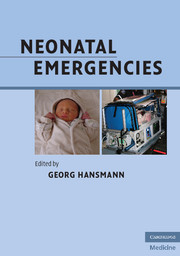Book contents
- Frontmatter
- Contents
- List of contributors
- Foreword (1)
- Foreword (2)
- Preface
- Acknowledgments
- Section 1 Organization of neonatal transport
- Section 2 Basics in cardiopulmonary resuscitation of newborn infants
- Section 3 Classic and rare scenarios in the neonatal period
- Section 4 Transport
- Section 5 Appendix
- Index
- Plate section
Foreword (2)
Published online by Cambridge University Press: 05 March 2012
- Frontmatter
- Contents
- List of contributors
- Foreword (1)
- Foreword (2)
- Preface
- Acknowledgments
- Section 1 Organization of neonatal transport
- Section 2 Basics in cardiopulmonary resuscitation of newborn infants
- Section 3 Classic and rare scenarios in the neonatal period
- Section 4 Transport
- Section 5 Appendix
- Index
- Plate section
Summary
Emergencies constitute a fundamental part of newborn medicine. I learned this the hard way shortly after I had finished medical school 35 years ago. As a research fellow in perinatal medicine I was offered to work for a week now and then in the neonatal intensive care unit, in spite of no formal training. After one or two days I had my first call and had to run to the obstetrical department, where a severely asphyxiated boy had been delivered. I have to admit that I did not know what to do. The insufficiency I felt and the incompetence of my handlings made me decide that this would not happen again. The fascination of dealing with and handling acute events in a satisfactory way has been an important part of my life ever since. However, I have never forgotten this boy at my first call, in spite of the fact that I, during the past 35 years, have dealt with thousands of severely ill newborn infants.
Today we talk about the first “golden minutes” of life: these precious minutes when it is so important to do everything as correctly as possible. We know today that newborn babies should not be ventilated with too high or too low tidal volumes and we know that we should avoid excessive oxygen even briefly. And so many acute events may occur in the nursery in the time following these first “golden minutes” after birth. For many of the most immature and vulnerable infants even small deviations from normality for a brief period may be catastrophic. It is a huge burden for health personnel to carry the future of the whole life of a human being during these important minutes – and not only the life of the newborn but also implications for their family.
- Type
- Chapter
- Information
- Neonatal Emergencies , pp. xv - xviPublisher: Cambridge University PressPrint publication year: 2009



